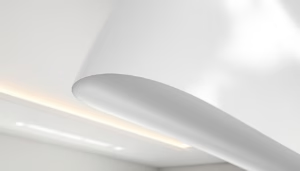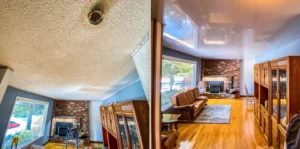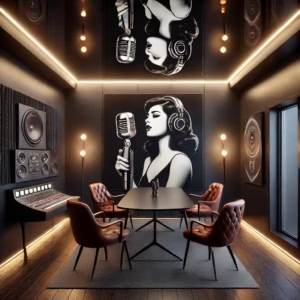At Space Ceiling, we’re often asked about the differences between traditional wallpaper and acoustic stretch walls.
While wallpaper has been a staple in interior design for centuries, acoustic stretch walls are revolutionizing how we think about wall treatments.
These innovative solutions offer unique benefits, from sound absorption to backlit options and even wall print stretch ceilings.
In this post, we’ll compare these two wall covering methods to help you make an informed decision for your space.
What’s the Deal with Regular Wallpaper?
Materials and Application
Regular wallpaper remains a popular wall covering option. Most wallpapers consist of paper or vinyl. Paper wallpapers offer an eco-friendly choice but lack durability. Vinyl wallpapers provide toughness and easy cleaning, making them suitable for high-traffic areas. The application process involves direct pasting onto the wall, which can be time-consuming and messy.
Design Options and Limitations
Wallpaper offers a vast array of patterns, colors, and textures. Options range from subtle textures to bold geometric designs. However, limitations exist. Custom designs often come with a hefty price tag, and you’re confined to standard roll widths (typically 21 or 27 inches). This restriction results in visible seams, particularly with patterned wallpapers.
Durability and Maintenance Challenges
The lifespan of wallpaper varies significantly based on quality and type. Traditional non-woven wallpapers generally outlast peel and stick varieties due to their stronger adhesion. Maintenance poses challenges. Most wallpapers don’t allow simple water wipe-downs, and stains often necessitate specialized cleaning products. Sunlight exposure can lead to fading over time, and humidity can cause peeling (especially in bathrooms and kitchens).
Acoustic Performance
Regular wallpaper offers minimal sound absorption properties. In spaces where noise reduction is a priority (such as home theaters or offices), traditional wallpaper falls short. This limitation has led many homeowners and businesses to explore alternatives that combine aesthetic appeal with practical acoustic benefits.
Environmental Considerations
The environmental impact of wallpaper varies. While paper-based options can be more eco-friendly, vinyl wallpapers (which contain PVC) raise concerns about off-gassing and disposal. Some manufacturers now offer eco-friendly wallpapers made from recycled materials or sustainable sources, but these options often come at a premium price.
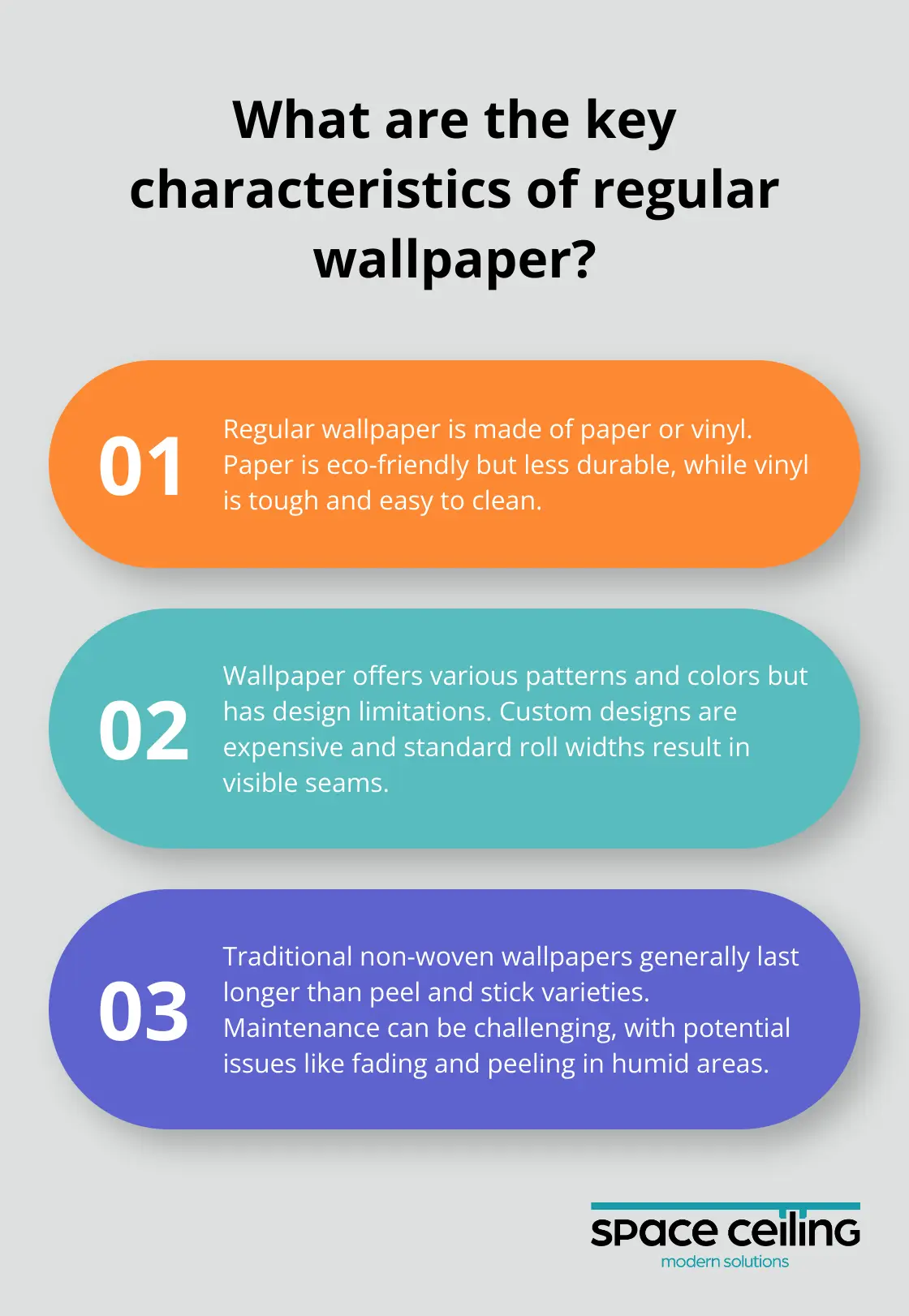
As we move forward, it’s important to consider how these characteristics of regular wallpaper compare to more innovative wall treatments. Let’s explore the world of acoustic stretch walls and see how they stack up against traditional options.
How Acoustic Stretch Walls Transform Spaces
The Science of Sound Absorption
Acoustic stretch walls consist of three main components: a perimeter track system, an acoustic core, and a fabric covering. The track system creates a framework for the acoustic core and fabric. The core (typically fiberglass or polyester) absorbs sound waves. A tensioned fabric stretches over the core and secures to the track system. Recent research has shifted focus from individual assemblies to controlling sound transmission in buildings as a whole. Traditional wallpaper offers minimal sound absorption in comparison.
Efficient Installation Process
Textile paper backing has more sound absorption and insulation properties than wallpaper. While wallpaper can take days to install and dry, acoustic stretch walls often take only hours. This quick turnaround benefits commercial spaces where downtime must be minimized. The process is cleaner and less disruptive. It requires no messy adhesives or extensive wall preparation. The track system installs over existing surfaces (including textured walls or old wallpaper), which saves time and labor costs.
Unparalleled Design Flexibility
Acoustic stretch walls offer extensive design options. They print with any design, from photorealistic images to abstract patterns. This allows for seamless, large-scale designs without the limitations of wallpaper roll widths. These walls can incorporate functional elements like LED lighting or serve as projection surfaces. The fabric replaces easily without removing the acoustic core, which allows for quick and cost-effective design updates. This feature proves particularly valuable in commercial spaces that require frequent rebranding or seasonal changes.
Durability and Maintenance
Acoustic stretch walls are designed to withstand everyday wear and tear, meaning they can last for years without showing signs of fading or chipping. They resist moisture, mold, and mildew, which makes them suitable for high-humidity areas (like bathrooms or basements). They clean easily – most fabrics wipe down with a damp cloth. This addresses one of the main maintenance challenges of regular wallpaper.
Cost Considerations
The initial cost of acoustic stretch walls may exceed traditional wallpaper. However, their longevity, acoustic benefits, and design flexibility often result in a more cost-effective solution long-term. As we move towards more multifunctional spaces (particularly with increased remote work), the ability to create quiet, aesthetically pleasing environments has become increasingly valuable.
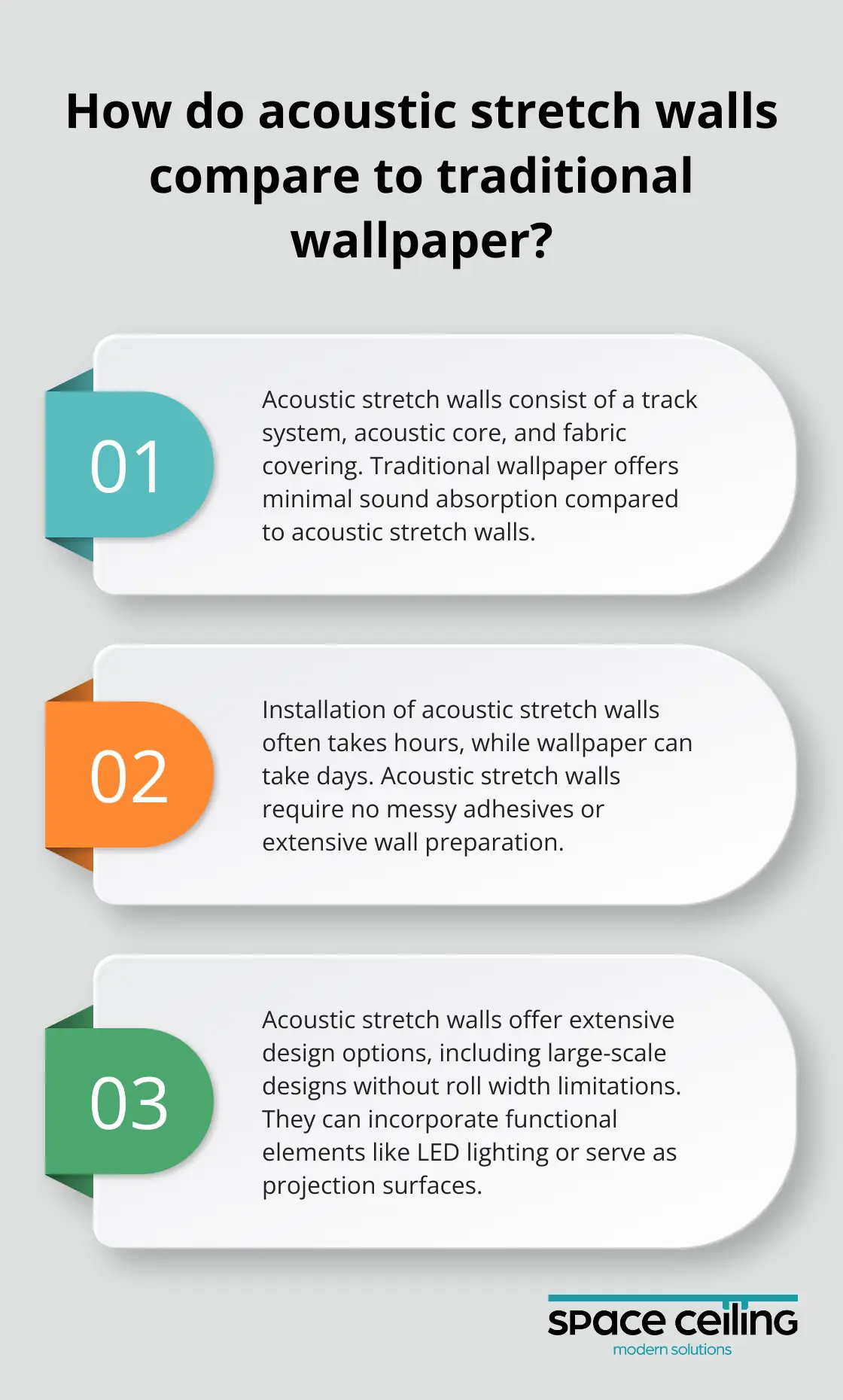
The versatility and performance of acoustic stretch walls make them an attractive option for various settings. Let’s now compare these innovative solutions with traditional wallpaper to understand which option best suits different spaces and needs.
Which Wall Treatment Reigns Supreme?
Sound Insulation: A Clear Advantage
Acoustic stretch walls outperform traditional wallpaper in sound insulation. While wallpaper provides minimal sound absorption, acoustic panels for walls are designed to absorb sound waves and reduce noise reflections in a room. They work by using materials that have acoustic properties. This makes them ideal for spaces where sound control matters (home theaters, offices, or restaurants). A National Research Council of Canada study found that properly installed acoustic treatments can improve speech intelligibility by up to 30% in open-plan offices.
Installation: Efficiency vs. Precision
Traditional wallpaper installation takes time. It requires meticulous wall preparation, precise cutting, and careful application to avoid bubbles or misalignments. On average, wallpapering a standard room can take 1-3 days.
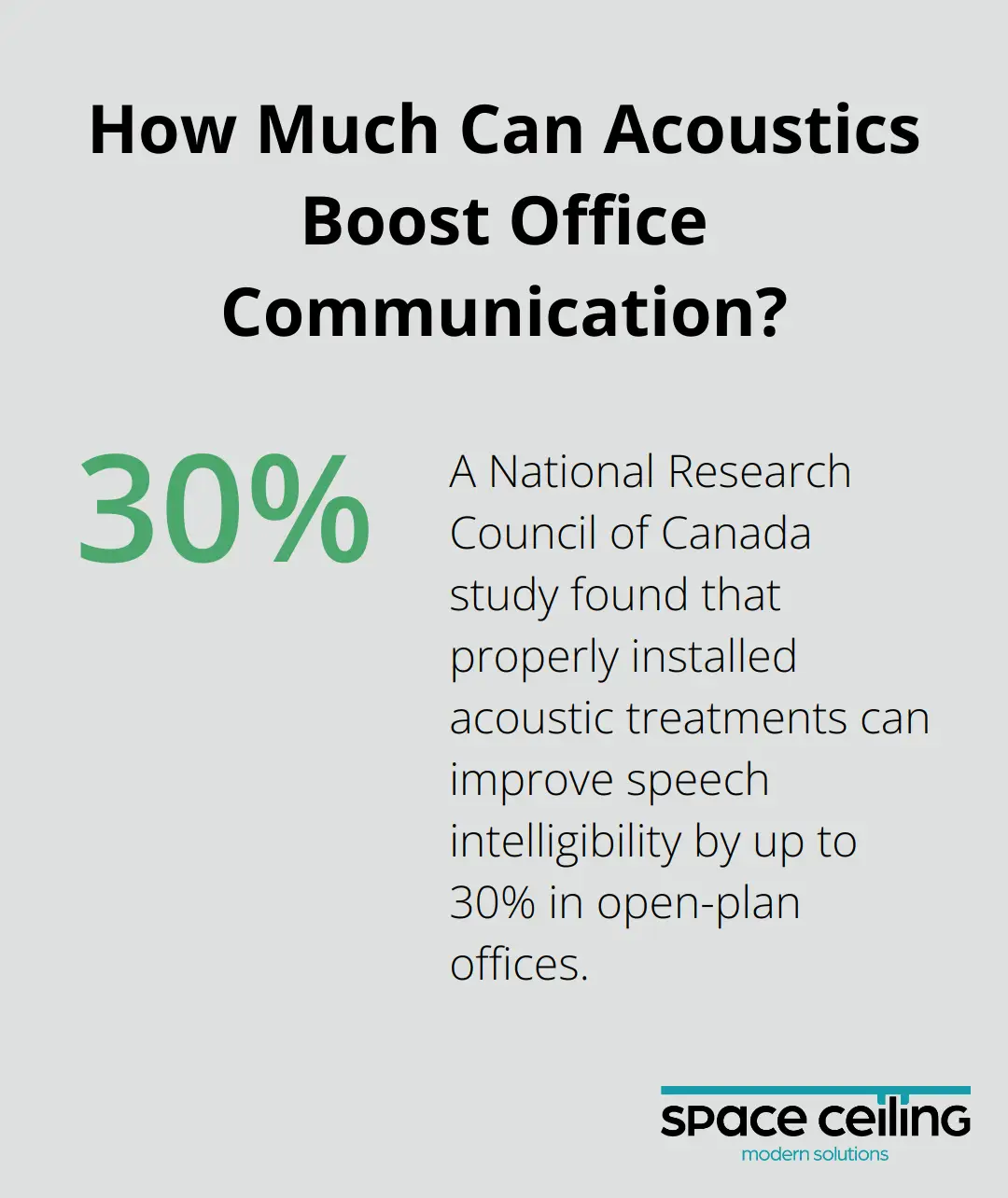
Acoustic stretch walls install in a fraction of the time. Novawall can accommodate curved walls and a wide array of geometries, whether installing on walls or ceilings. This rapid installation minimizes disruption, which benefits commercial spaces where downtime equals lost revenue.
Long-Term Value: Looking Beyond Initial Costs
Acoustic stretch walls may cost more upfront, but they often prove more economical over time. Here’s why:
- Durability: Acoustic stretch walls can last for many years with proper care.
- Maintenance: Wallpaper often needs special cleaning products and can be difficult to repair if damaged. Acoustic stretch walls clean easily with a damp cloth and allow partial replacement if necessary.
- Energy Efficiency: The insulating properties of acoustic stretch walls can lead to energy savings.
- Versatility: The ability to update designs or incorporate functional elements (like LED lighting) adds long-term value that traditional wallpaper can’t match.
Aesthetic Impact: Space Transformation
Both wallpaper and acoustic stretch walls can dramatically alter a room’s appearance, but they do so differently. Wallpaper limits itself by roll widths and repeat patterns, which can create visible seams and restrict large-scale designs.
Acoustic stretch walls offer seamless coverage and unlimited design possibilities. They can incorporate high-resolution prints, 3D textures, or even interactive elements. This flexibility allows for truly custom environments that can enhance brand identity in commercial spaces or create unique personal sanctuaries in homes.
Moreover, acoustic stretch walls can correct minor wall imperfections without extensive prep work. They work particularly well in older buildings where wall surfaces may be uneven or damaged.
The Final Verdict
The choice between regular wallpaper and acoustic stretch walls depends on specific needs, budget, and design goals. However, for those who seek a modern, versatile, and high-performance wall treatment, acoustic stretch walls offer compelling advantages that stand out in today’s design landscape.
Final Thoughts
Regular wallpaper and acoustic stretch walls both have their place in modern interior design. Acoustic stretch walls excel in sound absorption, quick installation, and versatility, making them ideal for spaces where aesthetics and functionality are equally important. These innovative solutions address practical concerns while offering design flexibility, including options like backlit ceilings and wall print stretch ceilings.
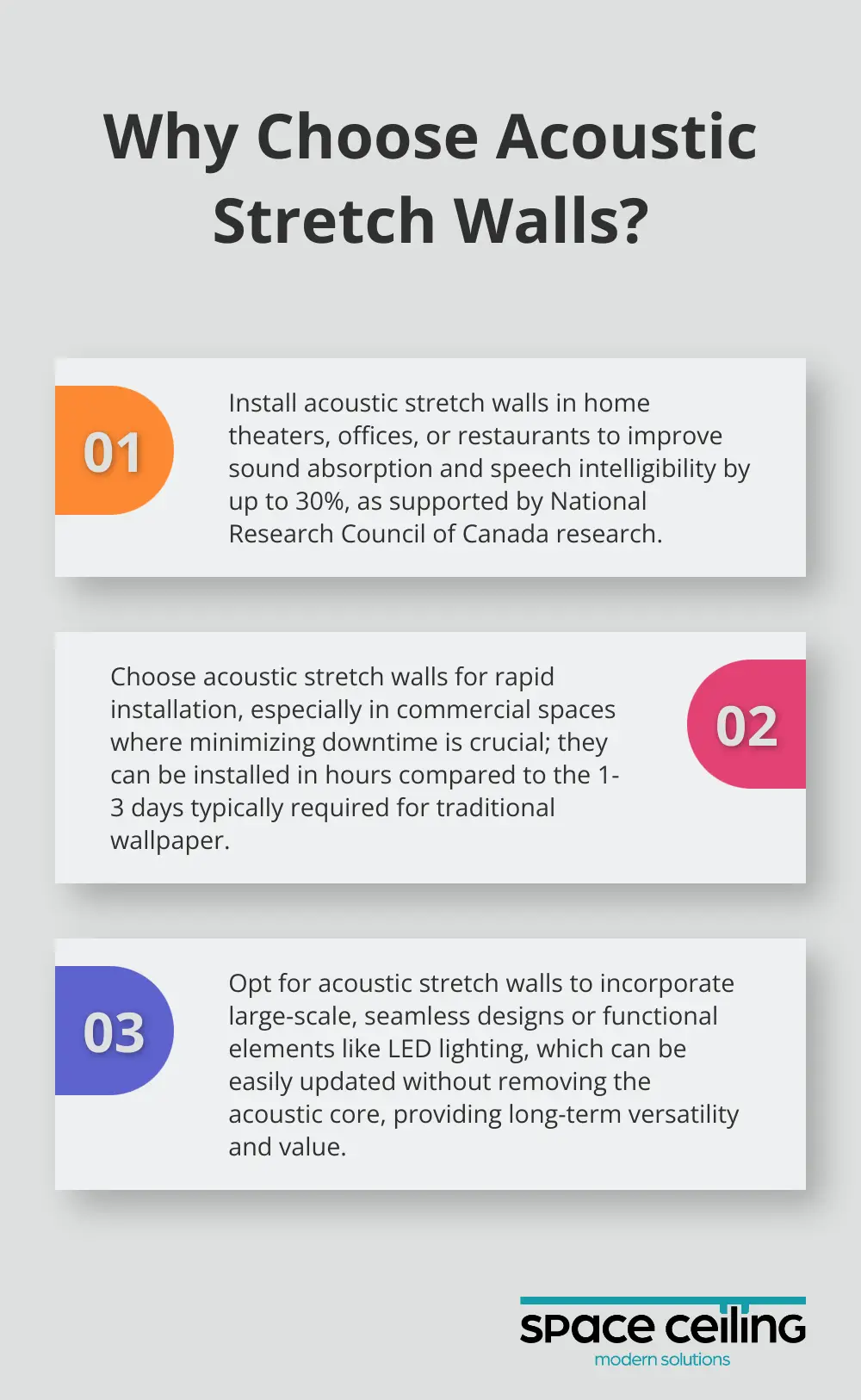
The future of wall treatments will likely focus on multifunctional solutions that enhance acoustic properties, energy efficiency, and customization options. As demand for versatile, high-performance interior solutions grows, products like acoustic stretch ceilings and walls will play an increasingly important role in shaping tomorrow’s spaces. This trend towards creating healthier indoor environments may also drive the development of more eco-friendly and antibacterial wall treatments.
Space Ceiling offers innovative solutions that combine cutting-edge technology with timeless elegance. Our products include acoustic stretch ceilings, backlit options, and wall print stretch ceilings. Space Ceiling provides advanced wall treatments that invest in comfort, functionality, and style for your home, office, or commercial space.
Originally posted on December 20, 2024 @ 10:08 am

